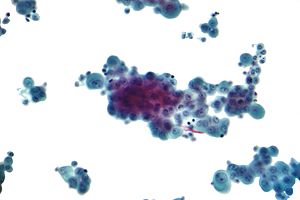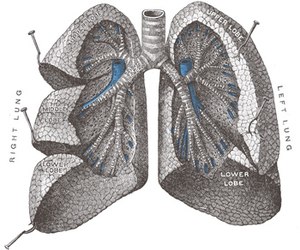 Image via Wikipedia
Image via WikipediaResearchers have generated altered immune cells that are able to shrink, and in some cases eradicate, large tumors in mice. The immune cells target mesothelin, a protein that is highly expressed, or translated in large amounts from the mesothelin gene, on the surface of several types of cancer cells. The approach, developed by researchers at the National Cancer Institute (NCI), part of the National Institutes of Health, and at the University of Pennsylvania School of Medicine, shows promise in the development of immunotherapies for certain tumors. The study appeared online the week of Feb. 9, 2009, in the Proceedings of the National Academy of Sciences.
Expression of mesothelin is normally limited to the cells that make up the protective lining (mesothelium) of the body’s cavities and internal organs. However, the protein is abundantly expressed by nearly all
pancreatic cancers and mesotheliomas and by many ovarian and non-small-cell lung cancers. Although the biological function of mesothelin is not known for certain, it is thought to play a role in the growth and metastatic spread of the cancers that express it.
"Since tumor cells are derived from the body’s normal cells, the immune system often does not recognize
tumor molecules as dangerous or foreign and does not mount a strong attack against them," said Ira Pastan, M.D., chief of the Laboratory of Molecular Biology in NCI’s Center for Cancer Research, a study collaborator. Moreover, even though it is possible to genetically engineer immune system cells to recognize molecules on tumor cells, most of the molecules found on tumor cells are also found on normal cells. But, Pastan notes, “Mesothelin is a promising candidate for generating tumor-targeting T cells, given its limited expression in normal tissues and high expression in several cancers."
Previous laboratory research has shown that certain immune system cells, called T cells, can kill tumor cells that express mesothelin. In addition, studies in both animals and humans have shown that antibodies directed against mesothelin protein can shrink tumors.
In the new study, the research team genetically engineered human T cells to target human mesothelin. To
produce them, a modified virus was used as a delivery vehicle, or vector, to transfer synthetic genes to cells. These genes directed the production of hybrid, or chimeric, proteins that can recognize and bind to
mesothelin and consequently stimulate the proliferation and cell-killing activity of the T cells.
In laboratory studies, the team found that the engineered T cells proliferated and secreted multiple cytokines when exposed to mesothelin. Cytokines are proteins that help control immune functions. The cells also expressed proteins that made them resistant to the toxic effects of tumors and their surrounding tissues.
To study the effects of the engineered T cells on tumor tissue, the researchers implanted human
mesothelioma cells underneath the skin of mice. About six weeks later, when tumors had formed and
progressed to an advanced stage, the engineered T cells were administered to the mice. Direct injection of the T cells into tumors or into veins of the mice resulted in disappearance or shrinkage of the tumor.
"Based on the size of the tumors and the number of cells administered, we estimate that one mesothelintargeted T cell was able to kill about 40 tumor cells," said study leader Carl H. June, M.D., professor of Pathology and Laboratory Medicine at the University of Pennsylvania School of Medicine and director of Translational Research at Penn's Abramson Cancer Center. "This finding indicates that small doses of these cells may have potential in treating patients with large tumors. Clinical trials are being developed to investigate this approach in patients with mesothelioma and ovarian cancer."
For more information on Dr. Pastan’s research, please go to http://ccr.cancer.gov/staff /staff.asp?profileid=5782.
For more information on Dr. June’s research, please go to http://www.med.upenn.edu/camb/faculty
/gt/june.html.



































